Chinese Journal of Tissue Engineering Research ›› 2024, Vol. 28 ›› Issue (21): 3418-3423.doi: 10.12307/2024.063
Previous Articles Next Articles
Classification and comparison of orthoses for adolescent idiopathic scoliosis and application progress of digital intelligent technology
Zhu Peikun1, Bai Jinzhu2, 3, 4
- 1School of Rehabilitation Medicine, Shandong University of Traditional Chinese Medicine, Jinan 250355, Shandong Province, China; 2Department of Spine and Spinal Cord Surgery, Beijing Bo’ai Hospital, China Rehabilitation Research Center, Beijing 100068, China; 3School of Rehabilitation Medicine, Capital Medical University, Beijing 100068, China; 4Department of Orthopedics, Capital Medical University, Beijing 100070, China
-
Received:2023-04-08Accepted:2023-05-10Online:2024-07-28Published:2023-09-28 -
Contact:Bai Jinzhu, MD, Chief physician, Department of Spine and Spinal Cord Surgery, Beijing Bo’ai Hospital, China Rehabilitation Research Center, Beijing 100068, China; School of Rehabilitation Medicine, Capital Medical University, Beijing 100068, China; Department of Orthopedics, Capital Medical University, Beijing 100070, China -
About author:Zhu Peikun, Master candidate, School of Rehabilitation Medicine, Shandong University of Traditional Chinese Medicine, Jinan 250355, Shandong Province, China -
Supported by:China Disabled Persons’ Federation Special Project on Assistive Devices, No. CJFJRRB03-2020 (to BJZ)
CLC Number:
Cite this article
Zhu Peikun, Bai Jinzhu. Classification and comparison of orthoses for adolescent idiopathic scoliosis and application progress of digital intelligent technology[J]. Chinese Journal of Tissue Engineering Research, 2024, 28(21): 3418-3423.
share this article
Add to citation manager EndNote|Reference Manager|ProCite|BibTeX|RefWorks
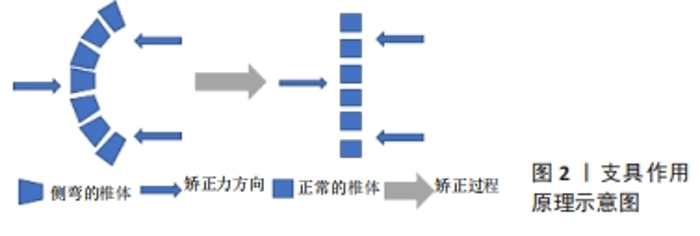
2.1 脊柱侧弯矫形器疗效的影响因素及作用原理 2.1.1 影响因素 初次诊断时的年龄越小,Risser征越低则侧弯进展的风险越大,此时介入治疗,畸形矫正的可能性也越大。脊柱的柔韧性同样会影响治疗,柔韧性越高,矫正的疗效越好,根据Lenke分型,胸腰弯或腰弯更容易矫正,而双主弯则不利于矫正[3]。畸形越早发现,侧弯角度越小,矫形器的疗效越好。双弯比单弯更容易加重。此外,患者对治疗的依从性很大程度上影响了矫形器的疗效,而影响患者依从性的原因是多方面的,矫形器种类的恰当选择以及适配度的提高有助于改善依从性。 2.1.2 作用原理 脊柱侧弯矫形器,又称脊柱支具,通过外固定的方式起到支撑治疗脊柱侧弯的作用,运用生物力学的三点力系统,改变脊柱及骨盆、胸廓和肩胛带的力学和运动学特征,通过Hueter-Volkmann定律,减轻凹侧压力,促进凹侧骨骺生长。其主要作用是矫正畸形,限制Cobb角的进一步进展,减轻局部疼痛,支持肌肉组织,减少手术治疗的必然性[4]。作用原理示意图见图2。"
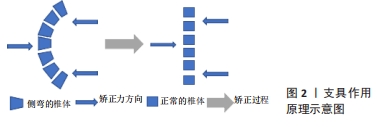
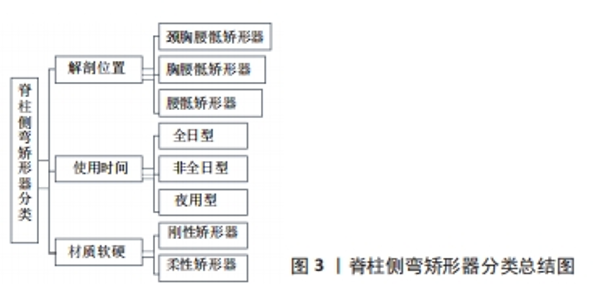
2.2 脊柱侧弯矫形器的分类 2.2.1 按解剖位置分类 脊柱侧弯矫形器按其解剖位置不同可分为颈胸腰骶矫形器(cervical-thoracic-lumbar-sacral-orthosis,CTLSO)、胸腰骶矫形器(thoracic-lumbar-sacral-orthosis,TLSO)和腰骶矫形器(lumbar-sacral-orthosis,LSO)。颈胸腰骶矫形器以密尔沃基支具为主,常见的胸腰骶矫形器包括波士顿支具、里昂支具、色努支具等。 2.2.2 按使用时间分类 按其时间分类,可分为全日型、非全日型和夜用型矫形器。大部分脊柱侧弯矫形器需全天佩戴,但是考虑到患者需要进行相应的运动治疗和身体清洁,一般建议全日型支具每天佩戴22-23 h。非全日型支具根据具体情况选择决定佩戴时间,而夜间型支具则只需在睡眠时佩戴8-10 h。 长期坚持按规定穿戴十分重要,依从性高的患者往往可以获得更好的疗效,DOLAN 等[5]对比BrAIST和ISICO脊柱侧弯患者支具治疗的失败因素,研究表明日平均佩戴时间可以显著影响矫形器有效性。MARUYAMA[6]发现长期的矫形器治疗即使存在矫形度数的丢失,但效果依然不可否认。然而,一些学者也提出了异议,PELTONEN等[7]认为每天穿戴支具12 h和23 h的治疗效果没有明显的差异,而PELLIOS等[8]在研究佩戴波士顿支具患者的曲度进展时,结果显示每天穿戴18 h或23 h在疗效上没有显著的不同。研究表明,夜间型支具的疗效并未随佩戴时间的减少而降低,可能与仰卧位下减轻了脊柱的轴向负荷有关[9]。 2.2.3 按材质硬度分类 按矫形器软硬分类,可分为刚性矫形器和非刚性矫形器(也称柔性支具)。刚性矫形器主要用热塑板材、硬塑料、金属等较硬的材质制作,多为固定式或框架式,不易变形,矫形力较强硬,对患者的躯干运动有较大的限制;柔性矫形器主要由弹力带、布料等弹性材料以及少量的硬性固定材料制作,整体较为柔软,对患者身体的限制较小,且二者的作用原理并不完全相同。 脊柱侧弯矫形器分类总结见图3。"
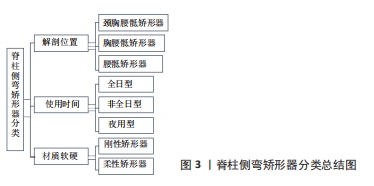
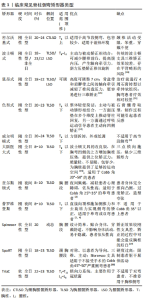
2.3 临床常见脊柱侧弯矫形器类型及其适应证与疗效 2.3.1 密尔沃基(Milwaukee)矫形器 全日型刚性支具,颈胸腰骶矫形器,适用于T6以上的胸段、颈胸段和颈段脊柱侧弯患者。由前后共3根支条、骨盆托和压力垫构成,包容较少,可用于湿热环境,可根据患者的生长状况调整高度。该支具对患者的日常生活活动限制较大,容易引起患者的抵触,从而降低佩戴的依从性。传统的密尔沃基支具经过长期佩戴,下颌托的压力可能导致牙齿畸形和下颌关节紊乱,改良后将下颌托更换为喉托[10],但依然会影响颈椎的活动。 MISTERSKA等[11]认为,虽然佩戴密尔沃基支具矫形效果较好,但是会给患者的社交生活和自我外观认识带来长期的负面影响。在 RAZEGHINEZHAD等[12]的研究中,密尔沃基支具对Cobb角在40°-55°患者的治疗效果并不理想。 2.3.2 波士顿式(Boston)矫形器 1972年由Hall和Miller共同创造研制的全日型对称性刚性支具,胸腰骶支具的主要代表之一,由密尔沃基矫形器发展而来,每天需佩戴18-23 h,适用于T8-L2的脊柱侧弯患者。传统波士顿支具根据患者体型选择不同型号的预制模型,然后由矫形师进行修剪,长期佩戴可能会导致患者平背畸形[13]。目前的波士顿支具依靠计算机辅助设计/计算机辅助制造(computer-aided design/computer-aided manufacturing,CAD/CAM)技术实现标准化定制,从3个平面作用于患者,从而提供更好的三维矫形效果[14]。支具后方开口,使用尼龙搭扣固定,具有较大的腹部压力,可减少腰椎的前凸并产生轴向牵引力,斜方的压垫起矫正椎体旋转的作用,支具内壁与患者身体之间留有空隙,可诱导患者身体运动,产生主动的矫正效果。 STEEN等[15]对365例穿戴波士顿支具的脊柱侧弯患者进行评估,1年后随访并重新拍摄X射线片,82%的患者Cobb角进展小于5°,且依从性高的患者效果更好。日本学者在波士顿支具的基础上,开发了大阪医大式矫形器,设计更加轻巧,减少了对身体的限制,在胸弯凹侧上方增加压垫,利用翻正反射进行胸椎矫正,取得较好的效果[16],适用于顶椎位于T8的患者。 2.3.3 色努式(Chêneau Type)矫形器 全日型非对称性刚性支具,适用于顶椎在T6以下的患者,是中国近几十年装配最多的脊柱侧弯支具。传统色努支具使用石膏绷带取型,得到阳模后进行修整,最后用热塑材料塑形制作,前方开口,开窗释放压力,整体轻便简洁。主动矫正与被动矫正相结合,一方面压垫在多个维度上推动脊柱回复,另一方面通过不对称呼吸运动引导患者主动向凹侧矫正。 RigoSystem Chêneau brace (RSCB)和Chêneau light brace以色努支具为基础,为满足不同人群而设计,分别开发于1990年和2005年[17]。WEISS等[18]用CAD/CAM技术设计开发了色努支具的衍生品Gensingen支具,扫描患者身体构架虚拟支具模型,降低人为错误风险,过程简短卫生,与患者更加适配,且效果明显,穿戴舒适。25例患者在佩戴Gensingen支具18个月后,成功率达92%,其中12例患者的Cobb角未出现明显进展,11例患者的Cobb角改善大于6°[19]。 WENIGER等[20]对159例使用色努支具的患者进行分析,平均随访(3.47±1.2)年,其中136例患者Cobb角进展小于5°,有效率达85.5%。对于Cobb角在20°-40°的患者,色努支具可以有效降低侧弯进展的风险。 2.3.4 里昂型(Lyon)矫形器 可调节框架式支具,由法国里昂的Stagnara医生设计的一款可以调节的矫形器,也称Stagnara支具,以三点力系统为基础,可根据患者的身高调整7 cm,适用于Cobb角在20°以上的快速发育期患者、Cobb角在30°以上的青春期发育缓慢者和Cobb角在40°以上且拒绝手术的患者[21]。治疗前,患者首先需进行4周的石膏铸型以牵伸软组织,在此基础上制作合适的支具。支具由前后各一根支条和可调整的压垫组装而成,包括2个保证支具稳定性的骨盆压垫,一个位于T12-L4的胸椎压垫,一个凸侧胸廓处的压垫,一个起反推作用的胸部压垫和一个凸侧的肩部平衡压垫,根据脊柱侧弯的位置和严重程度选择合适的矫正位置和矫正压力。在冠状面上,通过反推隆起的肋骨和肋软骨矫正椎体的旋转;在矢状面上,通过支条的弯曲控制控制胸腰椎的前后凸,骨盆带和肩胛带之间轴向牵引,减少了对椎间盘的压力,使三维矫正更加明显。AULISA等[22]分析了69例特发性胸椎侧弯女性患者接受里昂支具治疗后的效果,85.5%的患者侧弯得到一定程度的矫正,平均Cobb角从(31.5±4.3)°降至(16.3±9.6)°,13%的患者侧弯没有明显进展,这表明里昂支具对于治疗胸椎侧弯有着较好的效果。 经过60多年的发展,已开发出3种类型:胸椎支具、腰椎支具和胸腰椎支具,根据Lenke分型选择合适的矫形器。MAUROY等[23]用OrtenShape软件制作里昂支具3个分段的CAD/CAM模型并完成叠加,来代替石膏塑形,称之为ART brace,通过松解耦合运动完成脊柱的反扭转,在冠状面和矢状面上进行精准的过度矫正,矫正的效果要远优于传统里昂支具。 2.3.5 SpineCor柔性矫形器 动态柔性支具,由热塑材料的骨盆底座和大腿、躯干、肩膀上包裹着的坚韧的弹性带组成,弹性带的松紧度可调整。基于主动生物反馈机制,运动时弹力带拉伸诱导动态矫正,实现矫正运动中的神经肌肉的整合和再学习。支具需每天佩戴20 h,每次摘下不能超过2 h。 有研究表明SpineCor对AIS的治疗是有效的,并且在支具治疗结束后,矫正的度数不易丢失[24]。ERSEN等[25]的研究发现,价格昂贵的SpineCor因能为患者提供更好的生活质量而比胸腰骶矫形器支具更受患者及其家庭的欢迎。GUTMAN等[26]将SpineCor支具和波士顿支具进行比较,发现SpineCor在防止侧弯进展的方面不如波士顿支具,其中76%佩戴SpineCor的患者Cobb角进展大于6°,是普通刚性支具的2.67倍,患者手术的风险更高。且研究发现,SpineCor在长期佩戴中,可能会造成患者胸椎后凸畸形[27]。 2.3.6 查尔斯顿(Charleston)矫形器 夜间型非对成性刚性支具,只需在夜间睡眠时间佩戴,适用于单弯患者且Cobb角在25°-35°之间。较短的佩戴时间旨在提高患者的依从性,并减轻长时间佩戴和日间佩戴的心理障碍。但是,过度矫正和夸张的造型可能引起患者的不适。 BUYUK等[28]发现在胸腰椎/腰椎侧弯和Risser征1或2级的患者中,使用夜间型支具与使用全日型支具在防止侧弯进展方面效果相当,但是纳入的样本量和研究总体质量限制了推荐的力度;而RUFFILLI等[29]的回顾性研究则认为目前的研究不能得到夜间支具是否有效的准确结论,应谨慎使用。 2.3.7 Sforzesco矫形器 SpoRT支具的其中一种。SpoRT的概念是对称、以患者为导向、刚性、三维以及主动[30],包括Sibilla支具和Sforzesco支具。Sforzesco支具由高刚性材料制作,用铝条连接,对称分布,被称为“超刚性”支具,内嵌压垫以产生矫正力。ZAINA等[31]研究发现,在Cobb角大于40°的患者中,Sforzesco支具和ART支具的效果没有明显的差别。 临床常见脊柱矫形器的类型见表1。"
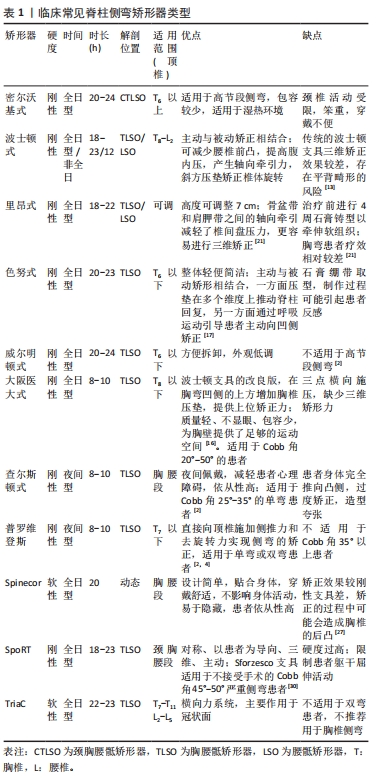

2.4 脊柱侧弯矫形器的研究进展 2.4.1 柔性矫形器得到更多关注 近年来,国际上有关柔性矫形器的研究和文献呈现与日递增的趋势。刚性支具在矫正侧弯的方面十分有效,但是长时间的静止与制动,可能会导致脊柱周围肌肉力量的下降,此外,还有影响心肺效率、不易调节、长时间穿戴会刺激皮肤等缺点[4]。相比较而言,柔性支具更具灵活性,可根据患者的需要进行调节,更加贴身,限制更少,穿戴更加舒适,不影响患者的运动;造型不似刚性支具的夸张,隐蔽性更佳,患者更易接受;总体而言更加适合现代人的生活观念,有利于提高依从性,虽然从疗效上看,其仍不如刚性支具,但是可以给患者提供更高的生活质量。 2.4.2 矫形器材料的进展 早期的脊柱侧弯矫形器多用金属、皮革和帆布等制成,之后逐渐被热塑材料取代,二战后聚甲基丙烯酸甲酯被首次应用于里昂支具,透明的外壳更容易观察到压力的变化。普罗维登斯矫形器在制作时使用了丙烯酸,能够以更小的不适换取更好的效果。目前的支具外壳多用聚乙烯和聚氯乙烯制作,这类热塑塑料耐热性好、不易腐蚀,具有较好的机械性能,费用也相对较低。 随着智能材料的发展,形状记忆合金(shape memory alloys,SMA)凭借其特殊的形状记忆效应和超弹性被逐渐的应用于矫形技术中。CHAN等[32]用形状记忆合金和不同的材料来替换脊柱侧弯柔性支具中的树脂支柱,发现形状记忆合金可以提供持续、可控的矫正力从而更有效地矫正胸椎的侧弯。 2.4.3 制作方式的进步 传统矫形器的制作方法,一是石膏铸造法,即石膏绷带取型,修整阳模,然后通过阳模塑形制作,这样的方法过程漫长且卫生较差;二是根据患者的侧弯情况和躯干大小,选择不同尺寸和型号的预制产品进行修剪。总体而言制作过程繁琐复杂,且通常无法达到精准矫正,可能会导致矫形度数的丢失。 随着科技的进步,数字化被广泛应用于医学行业,CAD/CAM、3D打印等技术逐渐兴起并替代传统的支具制作方法。通过3D扫描仪或光学相机,将患者的躯干信息导入计算机,由矫形师使用矫正软件,对虚拟模型进行修改设计以保证矫形效果,再进行正模的铣削雕刻,最后真空或热塑成型支具。CAD/CAM技术缩减了支具的制作时间和材料消耗,成品质地更轻,透气性更好,穿戴更舒适,很大程度上提高了患者的依从性[33],更加贴合患者的身体,可以达到精准矫正,不易丢失矫正度数,且制作过程简洁、干净。多项研究将传统方法制作的支具和CAD/CAM支具进行比较,结果表明CAD/CAM支具的依从性和耐受性更好,且其效果等同于甚至优于标准支具[34-35]。SANKAR等[36]研究发现相对于传统胸腰骶矫形器,更多的患者倾向于CAD/CAM支具。 此外,4D打印技术开始应用于生物医疗领域,CHENG等[37]根据植入物的特性设计了一款可以自动收缩并产生挤压力的腕-前臂夹板仿生矫形器,进一步为可穿戴设备的发展提供了创新的空间。4D打印技术与3D打印技术使用的是同一套技术,区别主要是4D打印使用了智能材料(如形状记忆合金等),增加了时间的维度,打印出的部件可以根据时间或其他环境参数而改变形状。该技术已经在骨科领域,如脊柱植入物、膝关节假肢等取得了积极的影响[38],有希望推动脊柱侧弯矫形器向新的方向发展。 2.4.4 矫形器动力的改变 最初的脊柱侧弯矫形器通过三点力系统改变人体的力学和运动学特征对脊柱施加去旋转力实现对侧弯的被动矫正。20世纪90年代研发的SpineCor柔性矫形器通过主动生物反馈,在人体的运动的过程中施加动态矫正。然而,这些矫形器都不能对特定脊椎提供可控的矫正力。PARK等[39]开发了一种机器人脊柱外骨骼(Robotic Spine Exoskeleton),在骨盆、腰部和胸部分别设计了3个环带,环带之间有2个并联的六自由度驱动模块,由6个带有位置与力传感器的执行机构组成,它可以控制和检测施加在特定区域的矫形力并及时的修改和调整。然而过多的执行器导致了质量和功率需求的增加,限制了使用的条件,所以有学者尝试使用Twisted String Actuation(TSA),一种基于绞合线和电机的平移传动系统,来制造质量轻、结构紧凑、机械简单的执行器[40]。 2.5 智能化与数据化新技术的应用 人工智能、大数据、物联网等技术是现代科学研究的热门领域,目前已广泛应用于康复医疗,为临床工作提供了更好的辅助,极大地提高了工作的效率。同时,这也为青少年特发性脊柱侧弯的诊治开辟了新的方向。 脊柱侧弯的筛选和诊断智能化,帮助医生减轻临床工作量,提高诊断的准确性,减少误诊、漏诊以及测量误差,提高工作效率。XIE等[41]开发了一种能够自动诊断脊柱侧弯并测量Cobb角的人工智能程序,由一个监督学习模块和一个推理模块构成,该程序首先对多张胸椎X射线片识别,并进行模型训练,然后根据训练好的模型推导出其他X射线片中的信息,在实际测试中准确率达到98.37%,且与人工实际测量之差只有(0.402±0.870)°。JIANG等[42]在脊柱超声成像的基础上结合人工智能,开发了UGBNet脊柱超声图像分割模型,可以准确识别脊柱超声图像且提高了分割精度,有利于之后脊柱3D形态的可视化,与传统的X射线片检查相比,该方法费用低廉且安全性高。HA等[43]建立了一个可以自动测量Cobb角的系统,该系统的性能可以达到放射科医生同等水平。WATANABE等[44]创建了一个脊柱侧弯筛查系统,使用卷积神经网络(convolutional neural networks,CNN)根据摩尔纹图像估计脊柱的排列,椎体旋转角度以及Cobb角,与专家的实际测量相比,脊柱排列的平均绝对误差为3.6像素,Cobb角的平均绝对误差为3.42°,椎体旋转角度的平均绝对误差为(2.9±1.4)°,该系统有望用于提高临床脊柱侧弯的筛查效率。 传统的支具治疗主要依靠临床医生的经验,存在着较高的失败率,而人工智能的应用则提高了支具的精准度,为支具的设计、效果和预后提供了更加有效的预测。SUN等[45]基于惯性测量单元(inertial measurement units,IMU),使用级联分类法和集成机器学习算法识别人体躯干运动模式,旨在应用于动态机械支具,使之能够准确实时地对人体的运动作出反应,并提供可控的动态矫形力。GUAN等[46]提出了一种基于知识库的专家系统,成功地应用于患者脊柱侧弯矫形器的设计,但是该系统只支持正向链推理,对于后向链推理和混合链推理则需要进一步研究。DENG等[47]设计了一套数据驱动的脊柱侧弯预后决策系统,对佩戴支具后不同情况下Cobb角的变化进行预测,医生可以通过对比结果进行评估并作出相应的决策。ZHAO等[48]开发了一套支具设计系统,旨在协助医生为患者设计侧弯支具,成功使支具的平均设计效率提高50%,且与专家实际操作偏差率小于10%。CHALMERS等[49]利用模糊推理模型开发了脊柱侧弯治疗结果预测系统,用以判断影响支具治疗的因素和治疗结果,并与多名专家组成的团队进行比较,该系统的表现优于几乎所有专家,可以为患者的治疗提供有价值的建议。关天民等[50]提出了一种基于模糊神经网络的脊柱侧弯支具设计模型,实际应用于患者后,结果表明该模型的精度为91.9%,预测值和实际值的相关系数0.841,证明其能够有效地对支具的参数和修整量进行初步的预测。 多项研究将患者身体、肌肉、体温等生理情况和矫形器的紧密性、矫正力、患者的依从性等进行了实时数据传输,旨在更好地观察治疗过程中患者的生理情况和佩戴依从性,判断当前的支具是否适合该患者,便于临床工作者及时的对支具进行相应的改进和调整,以提高疗效。ZHU等[51]设计了由无限压力传感器、微信小程序、云储存系统和网站后台管理系统组成的实时监控系统,通过观察患者上传的压力数据来评估患者穿戴支具的依从性。经过临床初步验证,患者的佩戴依从性随着使用时间的延长而显著增高。FUSS等[52]在支具内植入了一种经济高效且准确的压阻式传感器,通过监测患者在呼吸和不同活动期间的压力变化,来调整支具佩戴的舒适性。TYMI?SKA等[53]在色努支具的基础上增加石墨烯传感器薄膜以测量矫正过程中界面压力的变化范围,通过确定所需方向的最大有效压力来优化治疗效果。LIN等[54]开发了一款智能调压支具并进行了随机对照试验,在不影响生活质量的前提下自动调整压力,避免了因支具磨损导致的矫形力丢失,进一步提高了矫正效果。李会军等[55]利用触觉传感技术研发了智能脊柱矫形器,该装置可以实时监测患者的姿势,并对不良姿势加以提醒,通过配对的软件可以观察到患者的恢复状况,实验证明,该装置有较好的实用效果。 人工智能技术在脊柱侧弯的诊治中虽然取得一些进展,但其应用仍处于起步阶段,尚存在诸多不足,比如数据的采集不规范、技术研发难度大、技术本身存在缺陷、可能会导致医生的过度依赖以及当前的法律法规尚不健全等[56],还需要进一步的改进和不断地完善。同时,虽然大部分工作是通过人工智能的深度学习和模型训练完成的,但是这一切的基础是建立在医生的正确解读之上,对临床医生的素质仍有较高的要求。"

| [1] NEGRINI S, DONZELLI S, AULISA AG, et al. 2016 SOSORT guidelines: orthopaedic and rehabilitation treatment of idiopathic scoliosis during growth. Scoliosis Spinal Disord. 2018;13(1):1-48. [2] KAELIN AJ. Adolescent idiopathic scoliosis: indications for bracing and conservative treatments. Ann Transl Med. 2020;8(2):28-38. [3] PEETERS CMM, VAN HASSELT AJ, WAPSTRA FH, et al. Predictive Factors on Initial in-brace Correction in Idiopathic Scoliosis: A Systematic Review. Spine (Phila Pa 1976). 2022;47(8):E353-E361. [4] ALI A, FONTANARI V, FONTANA M, et al. Spinal Deformities and Advancement in Corrective Orthoses. Bioengineering (Basel). 2020;8(1):2-15. [5] DOLAN LA, DONZELLI S, ZAINA F, et al. Adolescent Idiopathic Scoliosis Bracing Success Is Influenced by Time in Brace: Comparative Effectiveness Analysis of BrAIST and ISICO Cohorts. Spine (Phila Pa 1976). 2020;45(17):1193-1199. [6] MARUYAMA T. Bracing adolescent idiopathic scoliosis: a systematic review of the literature of effective conservative treatment looking for end results 5 years after weaning. Disabil Rehabil. 2008;30(10):786-791. [7] PELTONEN J, POUSSA M, YLIKOSKI M. Three-year results of bracing in scoliosis. Acta Orthop Scand. 1988;59(5):487-490. [8] PELLIOS S, KENANIDIS E, POTOUPNIS M, et al. Curve progression 25 years after bracing for adolescent idiopathic scoliosis: long term comparative results between two matched groups of 18 versus 23 hours daily bracing. Scoliosis Spinal Disord. 2016;11(1):3-9. [9] SIMONY A, BEUSCHAU I, QUISTH L, et al. Providence nighttime bracing is effective in treatment for adolescent idiopathic scoliosis even in curves larger than 35°. Eur Spine J. 2019;28(9):2020-2024. [10] GLOWACKI J, LATUSZEWSKA J, OKRET A, et al. Temporomandibular Joint Disorders in Females with Adolescent Idiopathic Scoliosis: Long-Term Effects of Milwaukee Brace Treatment. J Clin Med. 2022;11(6):1721-1739. [11] MISTERSKA E, GŁOWACKI J, GŁOWACKI M, et al. Long-term effects of conservative treatment of Milwaukee brace on body image and mental health of patients with idiopathic scoliosis. PLoS One. 2018;13(2):e0193447. [12] RAZEGHINEZHAD R, KAMYAB M, BABAEE T, et al. The Effect of Brace Treatment on Large Curves of 40°to 55° in Adolescents With Idiopathic Scoliosis Who Have Avoided Surgery: A Retrospective Cohort Study. Neurospine. 2021;18(3):437-444. [13] CHEUNG JPY, CHONG CHW, CHEUNG PWH. Underarm bracing for adolescent idiopathic scoliosis leads to flatback deformity: the role of sagittal spinopelvic parameters. Bone Joint J. 2019;101-B(11):1370-1378. [14] WYNNE JH, HOULE LR. Short-Term Outcomes of the Boston Brace 3D Program Based on SRS and SOSORT Criteria: A Retrospective Study. Children (Basel). 2022;9(6):842-854. [15] STEEN H, PRIPP AH, LANGE JE, et al. Predictors for longterm curve progression after Boston brace treatment of idiopathic scoliosis. Eur J Phys Rehabil Med. 2021;57(1):101-109. [16] KUROKI H, INOMATA N, HAMANAKA H, et al. Predictive factors of Osaka Medical College (OMC) brace treatment in patients with adolescent idiopathic scoliosis. Scoliosis. 2015;10:11-16. [17] KARIMI MT, RABCZUK T. Scoliosis conservative treatment: A review of literature. J Craniovertebr Junction Spine. 2018;9(1):3-8. [18] WEISS HR, KLEBAN A. Development of CAD/CAM Based Brace Models for the Treatment of Patients with Scoliosis-Classification Based Approach versus Finite Element Modelling. Asian Spine J. 2015;9(5):661-667. [19] WEISS HR, TOURNAVITIS N, SEIBEL S, et al. A Prospective Cohort Study of AIS Patients with 40°and More Treated with a Gensingen Brace (GBW): Preliminary Results. Open Orthop J. 2017;11:1558-1567. [20] WENIGER CD, FUJAK A, HOFNER B, et al. Long-term Results of Conservative Therapy of Adolescent Idiopathic Scoliosis Using the Cheneau Brace. Klin Padiatr. 2019;231(5):248-254. [21] DE MAUROY JC, LECANTE C, BARRAL F. “Brace Technology” Thematic Series - The Lyon approach to the conservative treatment of scoliosis. Scoliosis. 2011;6:4. [22] AULISA AG, GUZZANTI V, FALCIGLIA F, et al. Lyon bracing in adolescent females with thoracic idiopathic scoliosis: a prospective study based on SRS and SOSORT criteria. BMC Musculoskelet Disord. 2015;16:316-322. [23] MAUROY JC, JOURNE A, GAGALIANO F, et al. The new Lyon ARTbrace versus the historical Lyon brace: a prospective case series of 148 consecutive scoliosis with short time results after 1 year compared with a historical retrospective case series of 100 consecutive scoliosis; SOSORT award 2015 winner. Scoliosis. 2015;10(1): 1-16. [24] COILLARD C, CIRCO AB, RIVARD CH. A prospective randomized controlled trial of the natural history of idiopathic scoliosis versus treatment with the SpineCor brace Sosort Award 2011 winner. Eur J Phys Rehabil Med. 2014;50(5):479-487. [25] ERSEN O, BILGIC S, KOCA K, et al. Difference between Spinecor brace and Thoracolumbosacral orthosis for deformity correction and quality of life in adolescent idiopathic scoliosis. Acta Orthop Belg. 2016;82(4):710-714. [26] GUTMAN G, BENOIT M, JONCAS J, et al. The effectiveness of the SpineCor brace for the conservative treatment of adolescent idiopathic scoliosis. Comparison with the Boston brace. Spine J. 2016;16(5):626-631. [27] JIANG J, QIU Y, MAO S, et al. The influence of elastic orthotic belt on sagittal profile in adolescent idiopathic thoracic scoliosis: a comparative radiographic study with Milwaukee brace. BMC Musculoskelet Disord. 2010;11:219-223. [28] BUYUK AF, TRUONG WH, MORGAN SJ, et al. Is nighttime bracing effective in the treatment of adolescent idiopathic scoliosis? A meta-analysis and systematic review based on scoliosis research society guidelines. Spine Deform. 2022;10(2):247-256. [29] RUFFILLI A, FIORE M, BARILE F, et al. Evaluation of night-time bracing efficacy in the treatment of adolescent idiopathic scoliosis: a systematic review. Spine Deform. 2021;9(3):671-678. [30] NEGRINI S, MARCHINI G, TESSADRI F. Brace technology thematic series - The Sforzesco and Sibilla braces, and the SPoRT (Symmetric, Patient oriented, Rigid, Three-dimensional, active) concept. Scoliosis. 2011;6:1-18. [31] ZAINA F, DE MAUROY JC, DONZELLI S, et al. SOSORT Award Winner 2015: a multicentre study comparing the SPoRT and ART braces effectiveness according to the SOSORT-SRS recommendations. Scoliosis. 2015;10:23-29. [32] CHAN WY, YIP J, YICK KL, et al. Mechanical and Clinical Evaluation of a Shape Memory Alloy and Conventional Struts in a Flexible Scoliotic Brace. Ann Biomed Eng. 2018;46(8):1194-1205. [33] WEISS HR, TOURNAVITIS N, NAN X, et al. Workflow of CAD / CAM Scoliosis Brace Adjustment in Preparation Using 3D Printing. Open Med Inform J. 2017;11:44-51. [34] SANZ-PENA I, ARACHCHI S, HALWALA-VITHANAGE D, et al. Characterising the Moul-d Rectification Process for Designing Scoliosis Braces: Towards Automated Digital Design of 3D-Printed Braces. Appl Sci-Basel. 2021;11(10):4665-4677. [35] DIARBAKERLI E, CHARALAMPIDIS A, ABBOTT A, et al. PReventing Idiopathic SCOliosis PROgression (PRISCOPRO): A protocol for a quadruple-blinded, randomized controlled trial comparing 3D designed Boston brace to standard Boston brace. PLoS One. 2021;16(8):e0255264. [36] SANKAR WN, ALBREKTSON J, LERMAN L, et al. Scoliosis in-brace curve correction and patient preference of CAD/CAM versus plaster molded TLSOs. J Child Orthop. 2007;1(6):345-349. [37] CHENG T, THIELEN M, POPPINGA S, et al. Bio-Inspired Motion Mechanisms: Computational Design and Material Programming of Self-Adjusting 4D-Printed Wearable Systems. Adv Sci (Weinh). 2021;8(13):2100411. [38] JAVAID M, HALEEM A. Significant advancements of 4D printing in the field of orthopaedics. J Clin Orthop Trauma. 2020;11(Suppl 4):S485-S490. [39] PARK JH, STEGALL PR, ROYE DP, et al. Robotic Spine Exoskeleton (RoSE): Characterizing the 3-D Stiffness of the Human Torso in the Treatment of Spine Deformity. IEEE Trans Neural Syst Rehabil Eng. 2018;26(5):1026-1035. [40] SEONG HS, KIM DH, GAPONOV I, et al. Development of a Twisted String Actuator-based Exoskeleton for Hip Joint Assistance in Lifting Tasks. // 2020 IEEE International Conference on Robotics and Automation (ICRA). 2020:761-767. [41] XIE L, ZHANG Q, HE D, et al. Automatically measuring the Cobb angle and screening for scoliosis on chest radiograph with a novel artificial intelligence method. Am J Transl Res. 2022;14(11):7880-7888. [42] JIANG W, MEI F, XIE Q. Novel automated spinal ultrasound segmentation approach for scoliosis visualization. Front Physiol. 2022;13:1051808. [43] HA AY, DO BH, Bartret AL, et al. Automating Scoliosis Measurements in Radiographic Studies with Machine Learning: Comparing Artificial Intelligence and Clinical Reports. J Digit Imaging. 2022;35(3):524-533. [44] WATANABE K, AOKI Y, MATSUMOTO M. An Application of Artificial Intelligence to Diagnostic Imaging of Spine Disease: Estimating Spinal Alignment From Moiré Images. Neurospine. 2019;16(4):697-702. [45] SUN PS, MAI JG, ZHOU ZH, et al. Upper-Body Motion Mode Recognition Based on IMUs for a Dynamic Spine Brace. // 2018 IEEE International Conference on Cyborg and Bionic Systems (CBS). 2018:167-170. [46] GUAN T, ZHAO D, MEI Z. Design and Implementation of a Knowledge-Based Expert System Shell. //2019 12th International Symposium on Computational Intelligence and Design (ISCID). 2019:204-207. [47] DENG L, HU Y, CHEUNG J, et al. A Data-Driven Decision Support System for Scoliosis Prognos. IEEE Access. 2017;39(9):7874-7884. [48] ZHAO Q, HUANG Y, WU M, et al. Study of Trunk Morphological Imbalance and Rehabilitation Outcome of Adolescent Idiopathic Scoliosis with Intelligent Medicine. Comput Intell Neurosci. 2022;2022:6775674. [49] CHALMERS E, PEDRYCZ W, LOU E. Human Experts’ and a Fuzzy Model’s Predictions of Outcome¬s of Scoliosis Treatment: A Comparative Analysis. IEEE Trans Biomed Eng. 2015;62(3):1001-1007. [50] 关天民,赵德竹,梅钊.基于模糊神经网络的脊柱侧弯矫形器设计模型[J].大连交通大学学报,2021,42(4):51-56. [51] ZHU C, WU Q, XIAO B, et al. A compliance real-time monitoring system for the management of the brace usage in adolescent idiopathic scoliosis patients: a pilot study. BMC Musculoskelet Dis-ord. 2021;22:152-159. [52] FUSS FK, AHMAD A, TAN AM, et al. Pressure Sensor System for Customized Scoliosis Braces. Sensors (Basel). 2021;21(4):1153-1172. [53] TYMIŃSKA P, ZABOROWSKA-SAPETA K, JANCZAK D, et al. TLSO with Graphene Sensors-An Applic¬ation to Measurements of Corrective Forces in the Prototype of Intelligent Brace. Sensors (Ba-sl). 2022;22(11):4015-4030. [54] LIN Y, LOU E, LAM TP, et al. The Intelligent Automated Pressure-Adjustable Orthosis for Patients With Adolescent Idiopathic Scoliosis: A Bi-Center Randomized Controlled Trial. Spine (Phila Pa 1976). 2020;45(20):1395-1402. [55] 李会军,陈蕊,宋爱国.基于分布式触觉感知的智能脊柱矫形装置研究[J].传感技术学报,2020,33(3):351-357. [56] 项林奕,朱津博,葛依婷,等.人工智能技术在脊柱侧凸诊疗中的应用进展[J].中华骨科杂志,2022,42(6):388-394. |
| [1] | Min Meipeng, Wu Jin, URBA RAFI, Zhang Wenjie, Gao Jia, Wang Yunhua, He Bin, Fan Lei. Role and significance of artificial intelligence preoperative planning in total hip arthroplasty [J]. Chinese Journal of Tissue Engineering Research, 2024, 28(9): 1372-1377. |
| [2] | Yu Weijie, Liu Aifeng, Chen Jixin, Guo Tianci, Jia Yizhen, Feng Huichuan, Yang Jialin. Advantages and application strategies of machine learning in diagnosis and treatment of lumbar disc herniation [J]. Chinese Journal of Tissue Engineering Research, 2024, 28(9): 1426-1435. |
| [3] | Wu Maodong, Su Qinglun, Huang Yiming, Shen Longying, Lu Yu, Zhao Qin. Correlation between coronal pressure variation and coronal imbalance in adolescent idiopathic scoliosis patients [J]. Chinese Journal of Tissue Engineering Research, 2024, 28(6): 852-856. |
| [4] | Ning Tianliang, Wang Kun, Wang Lingbiao, Han Pengfei. Finite element analysis on correction effect of varus foot orthosis based on the three-point force principle [J]. Chinese Journal of Tissue Engineering Research, 2024, 28(6): 891-899. |
| [5] | Zhao Rushun, Hao Yangquan, Xu Peng, Zheng Xin, Jiang Yonghong, Zhang Yuting, Wang Mengfei, Lu Chao. Effect of different locations of necrotic focus on the natural course of non-traumatic osteonecrosis of the femoral head [J]. Chinese Journal of Tissue Engineering Research, 2024, 28(6): 917-921. |
| [6] | Zhang Zhidong, Qi Jialong, Pei Shaobao, Ma Li, Wang Shansong, Liu Yiming. 3D printed guide template technique combined with multiple derotation for severe rigid scoliosis [J]. Chinese Journal of Tissue Engineering Research, 2024, 28(6): 922-926. |
| [7] | Liu Luxing, Di Mingyuan, Yang Qiang. Signaling pathways in the mechanism underlying active ingredients of Chinese medicine in the treatment of osteoarthritis [J]. Chinese Journal of Tissue Engineering Research, 2024, 28(4): 609-614. |
| [8] | Huang Jie, Shi Yanghua, Tan Zhen, Bo Zhandong. Free vascularized fibular grafting in treatment of femoral head osteonecrosis [J]. Chinese Journal of Tissue Engineering Research, 2024, 28(21): 3373-3379. |
| [9] | Hou Zhaomeng, Su Shaoting, Chen Longhao, Wei Guikang, Zhou Honghai. Visualization analysis of research hotspots and trends in adolescent idiopathic scoliosis [J]. Chinese Journal of Tissue Engineering Research, 2024, 28(21): 3424-3430. |
| [10] | Li Yinqian, Lyu Jie, Ding Lijun, Wang Duoduo, Guo Panjing, Cao Jinfeng, Zhou Nan, Lyu Qiang. Biomechanical characteristics of ligament injury affecting lumbar spine stability [J]. Chinese Journal of Tissue Engineering Research, 2024, 28(21): 3286-3292. |
| [11] | Yang Fangjun, Wang Fuyang, Su Yun, Wang Yongze, Yang Cunheng, Wang Tienan. Finite element analysis of intramedullary nail and locking plate fixation for proximal humeral fractures [J]. Chinese Journal of Tissue Engineering Research, 2024, 28(21): 3313-3318. |
| [12] | Xu Shizhuang, Chen Hongquan, Hou Jianwen, Sun Kefu. Correlation of tibial and fibular fractures in Pilon fractures [J]. Chinese Journal of Tissue Engineering Research, 2024, 28(21): 3355-3360. |
| [13] | Xie Peng, Zhang Jiang, Deng Xiaolei, Wei Bo, Hou Decai. A systematic review of mouse model construction for sarcopenia [J]. Chinese Journal of Tissue Engineering Research, 2024, 28(2): 263-266. |
| [14] | Wang Lihang, Lu Tingsheng, Chen Qiling, Yao Shudan, Pu Xingwei, Ji Linsong, Zhao Guoquan, Ouyang Beiping, Zhang Bin, Yang Zaisong, Luo Chunshan. Application of 5-point positioning point-contact pedicle navigation template in the case of scoliosis and complex pedicle [J]. Chinese Journal of Tissue Engineering Research, 2024, 28(18): 2859-2864. |
| [15] | Fu Rongchang, Yang Xiaozheng, Li Xianzheng. Biomechanical analysis of optimal Halo gravity traction in treatment of Lenke 3 scoliosis [J]. Chinese Journal of Tissue Engineering Research, 2024, 28(18): 2901-2905. |
| Viewed | ||||||
|
Full text |
|
|||||
|
Abstract |
|
|||||